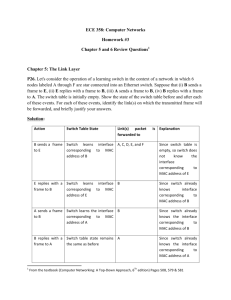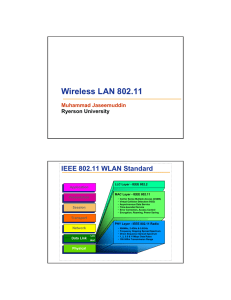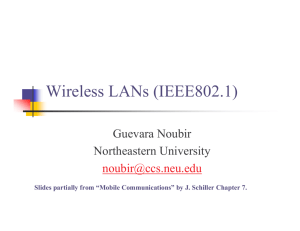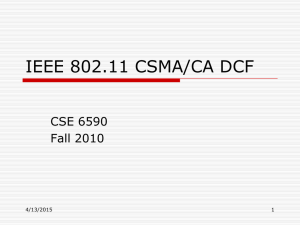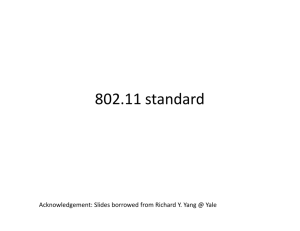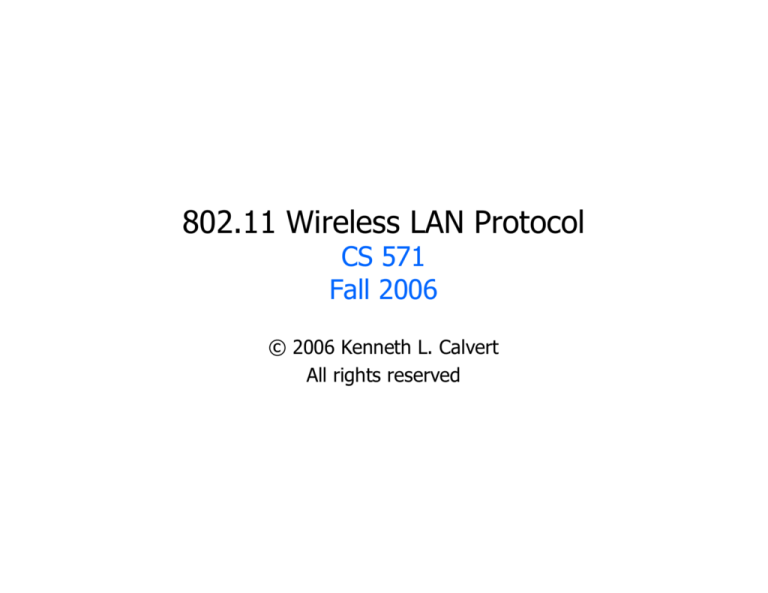
802.11 Wireless LAN Protocol
CS 571
Fall 2006
© 2006 Kenneth L. Calvert
All rights reserved
Wireless Channel Considerations
• Stations may move
– Changing propagation delays, signal strengths, etc.
• "Non-transitive" reception
– A can hear B, B can hear C, but A cannot hear C
• No "collision detection"!
– Detect unsuccessful transmission by absence of
acknowledgement
B
A
C
Wireless Channel Considerations, cont.
• Range of network limited by transmission power
– If equipment obeys transmit power limits, no way to exceed
maximum diameter
– Therefore max end-to-end propagation delay is limited
• Radio Frequency (RF) spectrum usage is restricted by
law/treaty!
– 802.11 uses 2.4 GHz band, sometimes called ISM
(Industrial, Scientific, Medicine)
– Applications using this range of frequencies must use Spread
Spectrum technology to minimize interference
– This band subject to interference by microwave ovens (2.43
MHz), cellular phones, Bluetooth, wireless microphones, ...
Pieces of the 802.11 Standard
Medium Access Control divided into two parts
– Distributed Coordination Function (DCF)
• Symmetric, all stations (including APs) behave the same way
• Carrier Sense Multiple Access with Collision Avoidance (CSMA/CA)
• Stations contend for access to medium
– Optional Point Coordination Function (PCF)
• Built on DCF
• Allows periods of contention-free operation interleaved with
periods of contention
• One station (typically AP) polls others to control who
transmits
– Note: importance of association function
• Permits more efficient operation under heavy loads
Pieces of the 802.11 Standard
Multiple PHYs:
Original 802.11 (1999):
• 2.4 GHz frequency-hopping spread spectrum @ 1, 2 Mbps
• 2.4 GHz direct-sequence spread spectrum @ 1, 2 Mbps
802.11a (1999):
• 5 GHz orthogonal FDM @ 6, 9, 12, 18, 24, 36, 48, 54 Mbps
802.11b (1999):
• 2.4 GHz direct-sequence spread spectrum @ 5.5, 11 Mbps
802.11g (2003):
• 2.4 GHz orthogonal FDM @ 54 Mbps
Architecture: Components
stations
BSS
access points (APs)
Distribution System (DS)
How this works is not
part of IEEE 802.11!
BSS = "Basic Service Set"
≈ A group of stations
communicating
BSS
MAC Protocol Design
• Different stations perceive events differently
⇒ Include explicit information about MAC state in transmitted
frames
E.g., duration of the next frame to be transmitted
Beacon frames inform stations about operational parameters
• Collision avoidance:
• Stations choose a random backoff interval before colliding!
(Compare to CSMA/CD: backoff only after colliding)
• Each station's backoff continues after other transmitted frames
(Helps with fairness)
• No collision detection: waste whole frames in collisions
⇒ Try to ensure collisions don't happen long frames
Exchange (short) control frames to clear the channel (RTS-CTS)
⇒ Include immediate ACKs as part of MAC protocol — retransmit if
no ACK received
802.11 MAC Protocol Services
• Contention-based Channel Access
– Some collisions may occur (but — "collision avoidance")
• Contention-free Channel Access (optional)
– No collisions (requires AP)
• Authentication of stations joining a network
– "Open System" = any station can be authenticated
• Confidentiality of data
– Using WEP or WPA encryption
• Association with a particular network ("BSS")
• MAC-level Acknowledgements
• Fragmentation and Reassembly
MAC Protocol Design
Wireless MAC Protocol Building Blocks:
– Clear Channel Assessment function (CCA): determines
whether/when medium is busy/idle
• Virtual Carrier Sense: use "Duration" fields in frames to infer
that medium should be busy, regardless of whether it is
sensed busy
– Inter-Frame Spacing (IFS) parameters
• Variable defer times allow coordination of management
functions with data transfer
– Slot time: basic unit of timing for the protocol
Equal to RxTx Turnaround Time + Channel Sensing Time +
Propagation Delay + MAC processing time
– Backoff timer: counts slots until station's turn to
transmit
Basic DCF MAC Protocol
Basic Time Parameters
– Slot Time: basic unit of backoff algorithm
= Time required for station to sense end of frame, start
transmitting, and beginning of frame to propagate to others
– SIFS: Short Inter-Frame Space
= Time required for station to sense end of frame and start
transmitting
– DIFS: DCF Inter-Frame Space
= Time to wait before starting backoff interval ("contending")
= SIFS + 2 slot times
slot
busy medium
SIFS
DIFS
Basic DCF MAC Protocol
If medium is free for ≥ DIFS → transmit
else back off:
Wait for medium to be free for DIFS
Choose a random r in [0,CW]
While r > 0:
sense medium for one slot time
if medium free throughout slot → r := r – 1
transmit frame
Immediate access
when medium is free
for at least DIFS
DIFS
Contention Window
DIFS
Busy medium
Defer
Frame
Slot time
Backoff Operation
Assume CW = 32
rA = 10
rA = 7
9 8 7
Station A
C's frame DIFS
DIFS
6 5 4 3
rA = 2
B's frame DIFS
2 1
A's frame
Frame arrival
rB = 8
rB = 5
7 6 5
Station B
DIFS
C's frame DIFS
4 3 2 1
B's frame
A's frame
Frame arrival
Station C
DIFS C's frame
Frame arrival
B's frame
A's frame
General Frame Format
2
FC
2
2
Dur
2
6
6
6
2
Addr1 Addr2 Addr3
4
Version Type Subtype
1
1
1
6
Seq Addr
Control 4
1
1
1
0-2312
2
Payload
FCS
1
1 bits
To From More Re- Pwr More
WEP Ordr
DS DS Frag try Mgt Data
0 = last fragment of packet
00 Management = Association, Authentication, Probe, Beacon
1 = another frame follows immediately
01 Control = RTS, CTS, ACK, Powersave-Poll
Rest of frame
10 Data = Data, Data + CF-Poll, is...Encrypted
bytes
General Frame Format
2
FC
2
6
Dur
6
6
Addr1 Addr2 Addr3
2
6
Seq Addr
Control 4
0-2312
2
Payload
FCS
bytes
Meaning/Presence determined by To/From DS bits
To DS
From DS
Addr 1
Addr 2
Addr 3
Addr 4
0
0
Dest
Source
BSSID
N/A
0
1
Dest
AP Addr
Source
N/A
1
0
AP Addr
Source
Dest
N/A
1
1
Receiver
Xmitter
Dest
Source
Example of Address Usage
A transmits:
sta
A
X transmits:
To DS: 1
From DS: 1
Addr 1: Y
Addr 2: X
Addr 3: B
Addr 4: A
To DS: 1
From DS: 0
Addr 1: X
Addr 2: A
Addr 3: B
Y transmits: To DS: 0
BSS X
From DS: 1
AP X
Addr 1: B
Addr 2: Y
Distribution System (DS)
Addr 3: A
AP Y
sta
B
Wireless LAN used
as Distribution System
BSS Y
General Frame Format
2
FC
2
Dur
6
6
6
2
Addr1 Addr2 Addr3
6
Seq Addr
Control 4
Sequence #
Frag #
12
4
0-2312
2
Payload
FCS
bits
Used for fragmentation & reassembly:
Sequence number assigned to each packet;
Sequence
# isare
also
used
to filter duplicate retransmissions:
Fragments
sent
in order;
Each
station
maintains
a "tuple cache"
of triples:
Each
fragment
is retransmitted
until ACKed!
(Addr2, seq#, frag#) and drops (but still ACKs) frames
whose tuples are in the cache. (Addr2 = transmitting sta)
bytes
MAC-level ACKs
• Upon receiving a frame addressed to it with a
correct FCS, a station immediately transmits an
ACK frame
A
B A
Data
SIFS
B
ACK
A
• If a station fails to receive a correct ACK frame
within a timeout, it retransmits (setting retry flag)
Request to Send – Clear to Send
• Before sending a long frame, send RTS
– "long" = length greater than RTSThreshold parameter
– RTSThreshold configurable per-station, range 0-2344+
• Recipient responds immediately with CTS
• Upon receiving CTS, immediately transmit Data
FC
Dur
Rcvr Sender
Addr Addr
FCS
Request to Send
FCS
Clear to Send
CTS + data frame
+ frame
ACK ++3 ACK
SIFS+ 2 SIFS
data
FC
Dur
Rcvr
Addr
RTS-CTS Operation
Note: SIFS is shorter than DIFS, so stations contending
for access do not decrement their backoff counters
during these exchanges
A
RTS B A
Data B A
SIFS
B
SIFS
CTS A
SIFS
ACK A
Network Allocation Vector (NAV)
• Each station maintains a countdown timer that
tells how far into the future the medium has
been "reserved" by RTS/CTS exchanges
• Stations set NAV counter based on the value in
the duration field of frames
– Even if a station only hears one side of the RTS-CTS
exchange, it knows how long the medium will be
"busy"
• CCA function combines NAV and physical
sensing
– Medium considered busy if NAV value > 0
General Frame Format
2
FC
2
Dur
6
6
6
Addr1 Addr2 Addr3
2
6
Seq Addr
Control 4
Duration of next frame, in microsecs (max 32,767)
RTS: duration of CTS + data frame + ACK + 3 SIFS
CTS: RTS duration – CTS – SIFS
Data w/ More Frags = 1: duration of next frag
Data w/ More Frags = 0: duration of ACK + SIFS
0-2312
2
Payload
FCS
bytes
Fragment Bursts
Duration
RTS
Duration
F:0 MF:1
SIFS
SIFS
CTS
Duration
X
F:1 MF:0
SIFS
SIFS
ACK
Duration
X
SIFS
ACK
Management: Who's Playing?
• MAC layer must provide stations a way to:
– Learn what SS's are available
– Associate with a particular SS (and authentication)
– Disassociate from a SS
• Beacon Frames are broadcast periodically by the Access
Point
Contains: SS ID, Access Point address (if any), Beacon frame
interval, supported data rates
• Stations may also send Probe frames to solicit
information from APs (sent in Probe response msgs)
• Management frames are transmitted with higher priority
– Implemented by using a smaller Priority Inter-frame Space
Point Coordination Function
• Idea: allow for explicit allocation of the channel
– AP acts as Controller, polls stations
– During a contention-free period, all stations see the
medium as busy (for purposes of contention)
• Frame types:
– Beacon (indicates start, duration of contention-free
period)
– CF-Poll, CF-Ack
– Data+CF-Poll, Data+CF-Ack, Data+CF-Poll+CF-Ack
• When polled, station may transmit 1 (data)
frame to any station
PCF Operation
PIFS
B: Data
+CF-Poll
SIFS
B A
SIFS
SIFS
A:CFPoll
SIFS
A
SIFS
PC
Beacon*
Data
ACK
B
C B
Data+
CF-Ack
• Special beacon marks beginning of CF period
– Sent after sensing medium idle for PIFS (< DIFS)
• Prevents other stations from contending for medium
– Indicates duration of CF period
• Non-PCF-capable stations set NAV to that value

